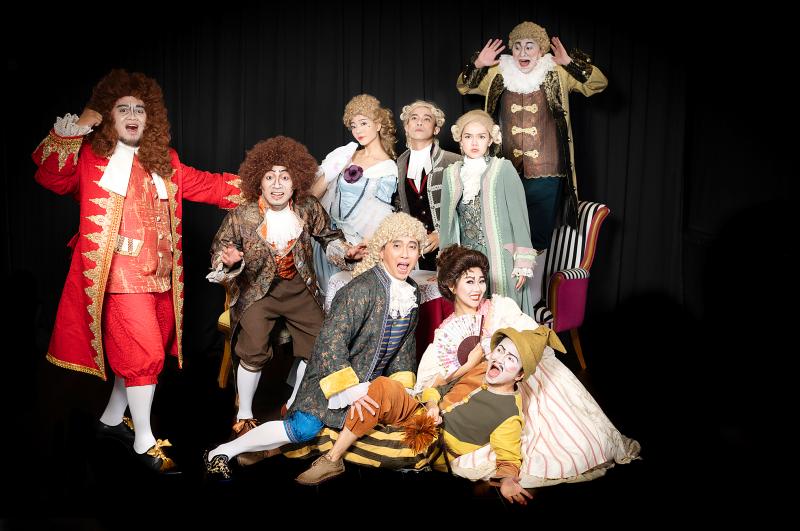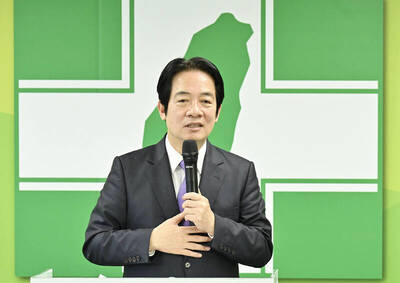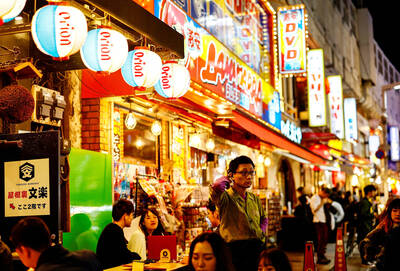Judging by Tang Tsung-sheng’s (唐從聖) performance in The Servant of Two Masters (一夫二主) on Saturday night at Taipei’s Metropolitan Hall, his nickname of Action Tang is well deserved.
Starring as Truffaldino, the servant at the heart of the play, Tang is rarely offstage or even at rest: He whines, wheedles, holds endless conversations with himself or the audience and is always on the hustle.
Performance Workshop (表演工作坊) founder Stan Lai’s (賴聲川) Mandarin-language adaptation of Carlo Goldoni’s 1743 play kept the improvisational, broad-based and often bawdy basics of the comedia dell’arte tradition of the Italian playwright’s original, but Lai also reduced the cast to a minimum by having everyone but Truffaldino double-up on roles, albeit with sometimes ill-disguised cover-ups.

Photo courtesy of The Performance Workshop
The compactness of the revival of the company’s 1995 production was also highlighted by Lai’s inventive set design, created for the company’s five-city tour in mind: the cast and crew are in Taichung for two shows tomorrow and Sunday at the Taichung Chungshan Hall, before heading further south in the coming weeks.
Lai designed a large steel box, made up for four open-sided cages on casters that each hold three or four brightly painted flats, which opens up to form the interior walls of a house, the exterior walls of an inn and a Venetian cityscape. A chandelier, along with a few more painted flats from the fly loft above the stage, a couple of chairs, boxes and tables round out the list.
Lai opens the play with the betrothal of Clarice and her true love, Silvio, watched over by her father, Pantalone, and his, Dr Lombardi, along with her maid Smeraldina and a family friend, the innkeeper Brighella.
The proceedings are interrupted by Truffaldino, who is looking for a job, and then Beatrice, who appears in the guise of her dead brother, Federigo, who had been set to wed Clarice in return for a substantial dowry.
Beatrice is hoping get her hands on Clarice’s dowry to support herself now that her brother is dead, thereby triggering a string of comedic errors and mistaken identities that finally ends with three couples paired off, including Truffaldino and Smeraldina.
Director Ismene Ting (丁乃箏) has proven once again that she has a flair for comedic timing and is not afraid to encourage her actors to go for over-the-top performances — which in this case is fitting, as all of Goldoni’s characters were based on stock comedia dell’arte characters. Occasionally the cast incorporated gestures and posturing from Chinese theater traditions.
Lee Shao-chieh (李劭婕) in the role of Beatrice/ Federigo was not always convincing when pretending to be a man, but Weng Quan-wei (翁銓偉) hammed it up as the money-obsessed, weak-bladder plagued Pantalone and Chou Yu-jou (周宇柔) as Clarice nailed the pouty rich girl mannerisms so beloved of Taiwanese soap operas.
Chu Chung-heng (屈中恆), as Beatrice’s beloved, Florindo — the second master of the title — spends most of the time looking aptly confused by the proceedings, while Lu Ming-yao (呂名堯) plays Silvio as immature, jealous and just itching to prove his sword fighting skills. Wang Jing-guan (王鏡冠) was quite rightly puffed up as the pontificating Lombardi.
Yeh Hsin-wei (葉信威) as Brighella gets to show off his acrobatic skills in the play’s famous banquet scene, along with Tang and Lu (playing one of his additional roles, this time a waiter), before everyone gets in on the barmy high jinks that cap the first act. However, Lee Fu-jung (李芙蓉) as Smeraldina does not have that much to do besides add commentary and wave a fan.
The Servant of Two Masters runs almost two-and-a-half hours with intermission, but Lai and Ting’s production provides an evening of goofiness. It’s hammy, but fun.
Following the Taichung shows, the company will give two performances on Saturday next week at the Kaohsiung Cultural Center’s Chih-Teh Hall, one evening performance on March 13 at the Tainan Municipal Cultural Center and one on March 20 at the Jhongli Arts Center. Tickets are priced from NT$600 to NT$3,000 and are available online at www.artsticket.com.tw and convenience store ticket kiosks.

May 11 to May 18 The original Taichung Railway Station was long thought to have been completely razed. Opening on May 15, 1905, the one-story wooden structure soon outgrew its purpose and was replaced in 1917 by a grandiose, Western-style station. During construction on the third-generation station in 2017, workers discovered the service pit for the original station’s locomotive depot. A year later, a small wooden building on site was determined by historians to be the first stationmaster’s office, built around 1908. With these findings, the Taichung Railway Station Cultural Park now boasts that it has

The latest Formosa poll released at the end of last month shows confidence in President William Lai (賴清德) plunged 8.1 percent, while satisfaction with the Lai administration fared worse with a drop of 8.5 percent. Those lacking confidence in Lai jumped by 6 percent and dissatisfaction in his administration spiked up 6.7 percent. Confidence in Lai is still strong at 48.6 percent, compared to 43 percent lacking confidence — but this is his worst result overall since he took office. For the first time, dissatisfaction with his administration surpassed satisfaction, 47.3 to 47.1 percent. Though statistically a tie, for most

In February of this year the Taipei Times reported on the visit of Lienchiang County Commissioner Wang Chung-ming (王忠銘) of the Chinese Nationalist Party (KMT) and a delegation to a lantern festival in Fuzhou’s Mawei District in Fujian Province. “Today, Mawei and Matsu jointly marked the lantern festival,” Wang was quoted as saying, adding that both sides “being of one people,” is a cause for joy. Wang was passing around a common claim of officials of the People’s Republic of China (PRC) and the PRC’s allies and supporters in Taiwan — KMT and the Taiwan People’s Party — and elsewhere: Taiwan and

Six weeks before I embarked on a research mission in Kyoto, I was sitting alone at a bar counter in Melbourne. Next to me, a woman was bragging loudly to a friend: She, too, was heading to Kyoto, I quickly discerned. Except her trip was in four months. And she’d just pulled an all-nighter booking restaurant reservations. As I snooped on the conversation, I broke out in a sweat, panicking because I’d yet to secure a single table. Then I remembered: Eating well in Japan is absolutely not something to lose sleep over. It’s true that the best-known institutions book up faster